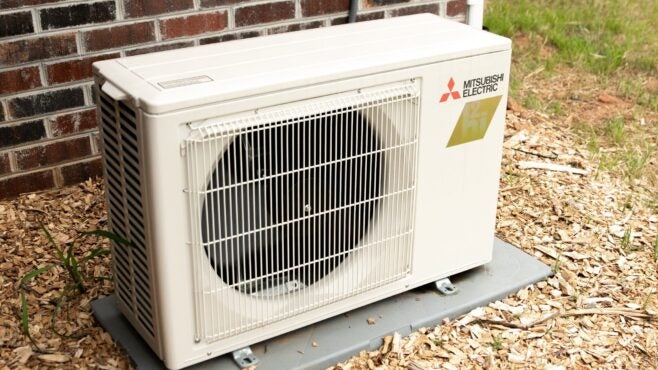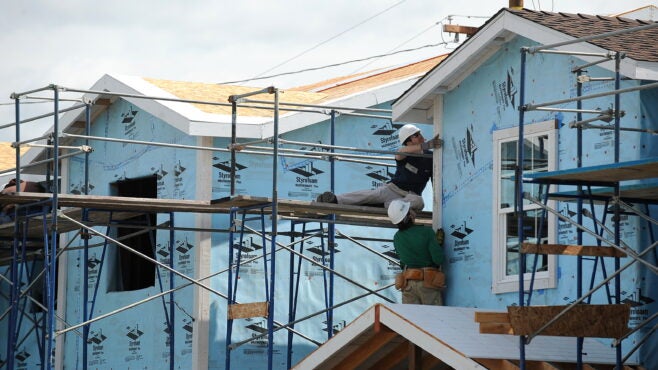Global leaders won’t be able to prevent runaway climate change without reducing greenhouse gas emissions from buildings. And to slash the carbon footprint of buildings, policymakers must tackle emissions from fossil fuels burned on-site in furnaces, boilers and water heaters.
Space and water heating account for nearly two-thirds of US household energy consumption. The good news for the prospects for a stabilised climate is that policy experts agree on one of the most effective technologies to decarbonise heating: heat pumps powered by carbon-free electricity.

Discover B2B Marketing That Performs
Combine business intelligence and editorial excellence to reach engaged professionals across 36 leading media platforms.
The elegance of heat pumps as a climate solution, and the explanation for their superior energy efficiency, is that they provide a two-for-one combination of heating and cooling from one unit without fuel combustion. Instead, heat pumps use electricity to draw heat indoors in winter and to expel heat outdoors in summer.

Heat pumps rely on the air or the ground as the thermal reservoir from which to extract or expel heat, depending on the season. Air source heat pumps are installed as centralised systems in buildings with ductwork, and in individual rooms or zones as part of mini-split systems in buildings without ducts. Ground source (or geothermal) heat pumps transfer heat to and from the earth via a network of pipes or a ground loop.
Heat pumps are up to three to six times more energy efficient than the fossil fuel-fired and electric-resistance equipment they replace. Recent technology improvements have made heat pumps viable even in cold climates, which means heat pumps can be used to decarbonise buildings almost anywhere.
Governments’ recognition of the readiness of heat pumps to play a crucial role in achieving climate targets is reflected in ambitious deployment targets and funding. Ireland plans to install 600,000 heat pumps by 2030. The UK aims to install 600,000 heat pumps annually by 2028. Germany’s millionth heat pump will be installed this year. The US state of Maine wants to install 100,000 heat pumps by 2025. New York state recently allocated $454m to deploy heat pumps through 2025.

US Tariffs are shifting - will you react or anticipate?
Don’t let policy changes catch you off guard. Stay proactive with real-time data and expert analysis.
By GlobalDataIn the US, heat pump installations have increased in recent years, in the absence of a push at the national level to promote the technology, partly because more new homes are all-electric. One in four US homes is all-electric, but 35% of the homes built in the US since 1980 use only electricity. Of the US’s 118 million households, 12 million use electric heat pumps as their primary source of heat, according to the US Energy Information Administration, with about three-quarters of the units installed in the temperate south-east.
Do heat pumps work in extreme cold?
Conventional wisdom has it that heat pumps do not work in cold climates. The conventional wisdom is wrong. High-performance, cold climate heat pumps can operate efficiently even at temperatures below -10°F (-23°C).
“The key feature allowing sub-freezing performance is an advance in variable speed inverter-driven compressor technology, which wasn’t available in mainstream offerings just ten years ago,” write Michael Gartman and Amar Shah, building electrification experts at the Rocky Mountain Institute (RMI), a Colorado-based think tank. This technology basically means that rather than a heat pump being fully on or off, it can operate anywhere in this range by analysing the temperature and conditions inside a building and adjusting its output to maximise efficiency.
Indeed, heat pump technology has advanced and improved to such an extent that Northeast Energy Efficiency Partnerships, a Massachusetts-based non-profit organisation, maintains a list of air source heat pumps that meet cold climate performance standards.
Will heat pumps save consumers and building owners money?
Yes, especially when installed in new buildings. Owners of existing buildings will see fuel savings over time. Homeowners who install a heat pump will see the investment pay off when a home is sold, too, according to a recent study.
“Heat pumps offer a feasible and energy-efficient way to electrify space heating,” conclude the authors of a recent Nature Energy paper. The researchers found that across 23 US states, homes with an air source heat pump saw a 4.3–7.1% sales price premium, worth $10,400–$17,000, on average.
“The lifetime fuel cost savings associated with a heat pump compared with a traditional HVAC system are large enough to compensate homeowners for the additional cost of installing an air source heat pump,” write the researchers. “The house resale price premium is large enough to compensate the installation cost of the heat pump.”
RMI research finds that new all-electric homes that use heat pumps for heating and cooling are cheaper than mixed-fuel homes in diverse climate zones across the US. The study examined the cost of newly constructed all-electric homes in Austin, Texas; Boston, Massachusetts; Columbus, Ohio; Minneapolis, Minnesota; New York City, New York; and Seattle, Washington.
“In every city we analysed, a new all-electric, single-family home is less expensive than a new mixed-fuel home that relies on gas for cooking, space heating and water heating,” write the authors.
In New York City, the upfront appliance costs for an all-electric home ($18,700) are cheaper than a mixed-fuel home ($21,600), assuming a conservative $2,100 cost for the gas connection, shows the study. Over 15 years, an all-electric home in New York City saves $6,800 in net present costs and avoids 46t of CO2 emissions.
Homeowners in north-east and mid-Atlantic US states have saved nearly $500 annually in reduced energy costs after replacing baseboard (electric-resistance) heating with air source heat pumps, says the New York State Energy Research and Development Authority. Savings for homeowners who have replaced fuel oil or propane-fired heating systems with air source heat pumps can reach nearly $950 each year.
What about existing commercial buildings? A recent American Council for an Energy-Efficient Economy (ACEEE) study of more than 2,000 existing buildings found that 27% of commercial floor space heated with fossil fuel furnaces, boilers and space heaters can be electrified today with heat pumps with a simple payback of less than ten years. Add energy efficiency investments, incentives and carbon pricing policies and 60% of the same floor space could be electrified with the same payback time. “Electrification of remaining buildings would likely require more aggressive policies or government investments,” the authors write.
Will heat pumps overly burden the grid?
It doesn’t appear so. A report published by the National Renewable Energy Laboratory found that economy-wide electrification in the US, including buildings and vehicles, could increase electricity consumption by up to 38% by 2050, but final energy use would fall by up to 21% because heat pumps and other electric equipment are more efficient than fossil fuel alternatives.
In swapping fossil fuel furnaces and boilers for heat pumps, owners of existing homes or businesses would be replacing oil, propane or gas on their utility bills with electricity. As the studies above find, building owners will save money over time in avoided fuel bills.
Even so, electrification must be coupled with redoubled efforts to improve energy efficiency. Reducing a building’s energy demand first with measures such as added attic and envelope insulation or sealing of leaky ducts and windows may enable owners to install a cheaper, smaller-capacity heat pump and reduce the upfront cost of going all-electric.

Grid planners and operators, meanwhile, should also be prepared for a new seasonal peak. If single-family homes in Texas swapped natural gas furnaces for electric heat pumps, households would save up to $452 annually on their utility bills, but the state’s power grid would shift from a summer-peaking to a winter-peaking system, according to Austin-based energy research organisation Pecan Street. “The grid could evolve to handle this,” says co-author Joshua Rhodes. “This is not a wholesale rethinking of how the grid would have to operate.”
Lawmakers can help grid operators ward off electricity usage spikes during extended cold weather events by investing in and enacting policies that promote widespread renovation of existing buildings, installation of programmable, grid-responsive heat pump water heaters, and deployment of long-duration energy storage.
Do heat pumps reduce emissions?
Yes, and because heat pumps run on electricity, they get cleaner as the power grid does. As many as 70 million US homes and businesses burn fossil gas, oil or propane on-site for space and water heating, says the RMI. In California, a household could reduce its annual emissions by 50–70% and 46–54% for water and space heating, respectively, by replacing fossil gas-fired equipment with heat pumps, according to a 2018 Natural Resources Defense Council study.
California’s 2045 carbon-free electricity and economy-wide carbon-neutrality targets ensure that fully electrified buildings will continue to reduce carbon for years to come. RMI researchers found that if California regulators delayed enacting an all-electric requirement for new construction by three years, until 2025, it would cause three million additional metric tonnes of carbon emissions by 2030 and more than $1bn of unnecessary spending on new gas infrastructure.
Germany’s million heat pumps are estimated to have reduced CO2 emissions by 17 million tonnes, according to BWP, a heat pumps trade association. In the ACEEE commercial buildings study, researchers found that electrifying heating in the 2,000-plus buildings analysed would reduce on-site energy use by 37% and greenhouse gas emissions by 44%.
Deploying heat pumps in all-electric buildings
Increasingly, building standards will expand the market for heat pumps, too.
In California, 40 local governments, including large cities such as San Francisco, San Jose and Oakland, have passed ordinances that require or encourage all-electric buildings in new construction. Officials at the California Energy Commission will soon decide whether to include an all-electric baseline in the 2022 update to the state’s Title 24 Building Energy Efficiency Standards.
In the Australian Capital Territory (ACT), lawmakers amended a law that mandated gas delivery to all new housing developments, which made possible Ginninderry Estate, an all-electric, 100% solar-powered project in a Canberra suburb. More all-electric projects are planned in Canberra, including a hospital, an office precinct for ACT government employees and a business district.
The European Commission’s recently adopted Renovation Wave strategy aims to at least double EU renovation rates to upgrade 35 million inefficient buildings by 2030. The EU’s Strategy for Energy System Integration says the share of electricity in residential heating demand should reach 40% by 2030 and up to 70% by 2050.





